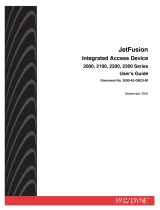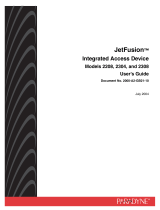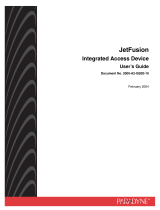Page is loading ...

Revision: 2.0
User's Manual

May 18, 2000
Revision Number:2.0 SDSL Modem
i
SDTU-01/ET10
T
T
a
a
b
b
l
l
e
e
o
o
f
f
C
C
o
o
n
n
t
t
e
e
n
n
t
t
s
s
1. Overview.................................................................... 1
2. Features .................................................................... 1
3. Packaging.................................................................. 1
4. Appearance ............................................................... 2
5. Hardware Installation.................................................. 3
6. Management.............................................................. 4
7. Default values............................................................ 5
8. Software Upgrade ...................................................... 6
Appendix A. Console Setup................................................ 7
Appendix B. Command Line Interface................................. 8
Appendix C. Specifications............................................... 25
Hardware Specifications............................................... 25
Software Specifications................................................ 26

May 18, 2000
Revision Number: 2.0 SDSL Modem
ii
SDTU-01/ET10
T
T
a
a
b
b
l
l
e
e
o
o
f
f
F
F
i
i
g
g
u
u
r
r
e
e
s
s
FIGURE 1: FRONT PANEL ...................................................................2
FIGURE 2: REAR PANEL.....................................................................2
FIGURE 3: HARDWARE INSTALLATIONS ................................................3
FIGURE 4: COMMAND TREE.................................................................9

May 18, 2000
Revision Number: 2.0 SDSL Modem
iii
SDTU-01/ET10
R
R
e
e
v
v
i
i
s
s
i
i
o
o
n
n
M
M
a
a
r
r
k
k
s
s
Revision Date Notes
V2.0 May 25, 2000 Software: 2.11B-H30.02-F45.108

May 18, 2000
Revision Number: 2.0 SDSL Modem
1
SDTU-01/ET10
1. Overview
The SDTU-01/ET10 is an SDSL modem supporting ATM bridging with
4-port 10Base-T Ethernet hub. The SDSL front end provides
symmetrical data rates from 144Kbps up to 2320Kbps in
programmable rate steps of 8Kbps. The SDTU-01/ET10 can be
configured to inter-operate with SDSL DSLAM or to support Point-to-
Point data transmission applications by flexible CO/RT configuration.
2. Features
ü High Speed Symmetrical Data Transmission on Single Twisted Copper
Pair Wire
ü 2B1Q Line Coding
ü Symmetrical Multi-rate data transmission from 144Kbps up to
2320Kbps
ü RFC 1483 Bridging over ATM over SDSL
ü 4-port 10Base-T Ethernet hub for PC/LAN
ü High quality, simple operation, low power consumption
ü Compatible and interoperable with major Central Office side SDSL
DSLAM or Multi-service Access System
ü Local OAM&P through command line interface via RS-232 Craft
port
ü Local Telnet through the Ethernet interface
ü Remote Telnet through SDSL interface
ü Supports point-to-point applications
3. Packaging
This package consists of the following items:
4 The SDTU-01/ET10 unit
4 AC Adapter
4 Installation and Operation Manual
4 9-pin to 9-pin serial configuration cable

May 18, 2000
Revision Number: 2.0 SDSL Modem
2
SDTU-01/ET10
4. Appearance
Front Panel
Figure 1: Front Panel
Rear Panel
Figure 2: Rear Panel
WAN Status: Blinks while training with DSLAM and On
when SDSL link is ready
Power: On when the power supply is properly connected.
Activity: Blinks while transmitting or receiving packets over one of Ethernet
ports
LINK Status: On when one of Ethernet ports is properly connected to a
LAN or PC
RJ11, SDSL inlet
RJ45*4, for connection to LAN or PC
Power Jack, for connection to an AC-DC power adapter, 12VDC, 1A
DB9, serial port for connection to ASCII data terminal
Alarm: Blinks while booting up, and On when there is
an error, continuous “On” indicates internal error
Green LED*4, On while corresponding Ethernet port is
connected. Blinks while transmitting or receiving
packets
Red LED, on when Ethernet
collision occur

May 18, 2000
Revision Number: 2.0 SDSL Modem
3
SDTU-01/ET10
5. Hardware Installation
1. Connect the SDSL cable, (item 1) indicated in Figure 3, to
the LINE port of RJ-11 socket.
2. Use a RJ-45 cable, (item 2) indicated in Figure 3, to connect
the SDTU-01/ET10 to the LAN or a PC with Ethernet adapter
installed.
Note: Be sure to use RJ-45 cross-over cable when
connecting to a hub.
3. Plug in the AC adapter to an AC power socket, then connect
the DC jack, (item 3) indicated in Figure 3, the DC inlet of the
SDTU-01/ET10.
4. Use a 9-pin RS-232 cable (item 4) indicated in Figure 3, to
connect the Console Port to a serial port of a terminal such
as PC with data terminal emulation software (Hyper Terminal)
installed, in order to perform local management.
Figure 3: Hardware Installations
(1)
(2)
(3)
(4)
SDSL outlet
Management Terminal

May 18, 2000
Revision Number: 2.0 SDSL Modem
4
SDTU-01/ET10
6. Management
SDTU-01/ET10 supports simple, flexible and easy-to-operate
methods for management purposes. The SDTU-01/ET10 can be
managed via the following paths, refer to Appendix B for
detailed information.
ü Console port – use the RS-232 cable for connecting SDTU-
01/ET10 to a console terminal or a PC running terminal
emulation program, such as Hyper Terminal, see Appendix A for
proper console setup.
ü Local Ethernet Port – connect the Ethernet port to your local
area network or to a PC directly, “Telnet” SDTU-01/ET10 from any
workstation on the LAN.
ü SDSL port from remote site – while SDSL connection is in
service, you may remotely “Telnet” SDTU-01/ET10 from a
workstation networking to the CO equipment.
Note: As operating SDSL modem requires technical know-how and
experience, it is recommended that management of the SDTU-
01/ET10 be performed by qualified technical staff only.

May 18, 2000
Revision Number: 2.0 SDSL Modem
5
SDTU-01/ET10
7. Default values
SDTU-01/ET10 is pre-configured with the following parameters; the
user may also re-load the default parameters by selecting Default from
the main menu.
LAN and VC setting WAN and SDSL
Ethernet (local) IP: 192.168.2.1 Side selected: CPE (RT) side
Subnet mask: 255.255.255.0 Auto Rate: disable
Protocol: RFC1483, bridge Mode Rate select: 2320Kbps
VPI/VCI: 8/35 Sign/Magnitude Bit Sequence: reverse
Spanning tree: disable Data Bit Polarity: Normal
Packet control: IP and PPPoE Scrambling: enable
Idle-cell-sending: enable

May 18, 2000
Revision Number: 2.0 SDSL Modem
6
SDTU-01/ET10
8. Software Upgrade
You may easily upgrade the SDTU-01/ET10's embedded
software by obtaining the compressed upgrade kit, ZIP file, from
the service provider then following the steps:
ü Extract the ZIP file
ü Connect SDTU-01/ET10 via the local Ethernet port or remote
SDSL link, make sure the SDTU-01/ET10 Ethernet IP address is
set and your terminal is properly configured so you can
successfully “ping” SDTU-01/ET10.
ü Under a DOS prompt, execute the command line “xupgrade
<IP address of SDTU-01/ET10>”, for instance “xupgrade
192.168.2.1”.
ü This upgrade process may take as long as 60 seconds.
ü Then reboot SDTU-01/ET10 with new software.
NOTE: Strictly maintain stable power to SDTU-01/ET10 while
upgrading software. If power fails during the upgrading
process, contents in the memory could be destroyed and
the system may hang. In such a case, you must call the
dealer or system integrator for repair.

May 18, 2000
Revision Number: 2.0 SDSL Modem
7
SDTU-01/ET10
Appendix A. Console Setup
Connect the RS-232 console port to an ASCII data terminal or a PC
with Windows serial Terminal mode of VT-100 (Hyper Terminal). To
Start the Hyper-terminal, following the steps below:
1. Start "Hyper-terminal" program --
− On Windows 98 or Windows NT: start Tool Bar à Program à
Accessory à Hyper Terminal Group à Double Click Hypertrm.exe à
Enter Connection Name à Select Icon à Click OK
2. Select COM port to communicate with SDTU-01/ET10
− Choose direct to COM1 or COM2 à click OK
3. Set Port Properties --
4 Port Setting:
− Bit per second: 9600
− Data bits: 8
− Stop bits: 1
− Parity bits: None
− Flow Control: None

May 18, 2000
Revision Number: 2.0 SDSL Modem
8
SDTU-01/ET10
Appendix B. Command Line Interface
The command line interface allows you to change the SDSL, ATM and
Ethernet parameters, and display the status as well. Some commands must
be followed by parameters for proper configuration of the modem.
Conventionally, there shall be a “space” between a command and its
corresponding parameters.
The punctuation marks in the command line interface have their different
meanings. The syntax < > means the parameters that are enclosed are
compulsory, [ ] means that the parameters are optional, and || between
parameters means either….or. In the parameters section “ “ means that
the parameters are Key Words. Furthermore, after entering the password,
the screen will show the prompt as > for command entry.
There are two hierarchical levels in the command line interface. The
command tree below will show the user the hierarchical relationship and
commands supported:
Note 1: When password is applied, the connection will time out after 3
minutes if there is no access to the modem. Password entering is
necessary to resume connection.
Note 2: All settings will become effective only after being saved.

May 18, 2000
Revision Number: 2.0 SDSL Modem
9
SDTU-01/ET10
Main menu
default
¢w
setip
r1483
sdsl
show
ver
restart
save
setspan
setpvc
pfilter
delpvc
lan
list
ping
manage
quick
¢w
setpass
auto
cell
dbit
default
enable
rate
scramble
smbit
status
terminal
version
Figure 4: Command Tree

May 18, 2000
Revision Number: 2.0 SDSL Modem
10
SDTU-01/ET10
COMMAND LINE INTERFACE CONVENTIONS
HELP or ?
Lists all commands at the current level menu and follow by simple
description of each command
Syntax:
help
Parameters:
Example:
> help
Syntax:
?
Parameters:
Example:
> ?
HELP <command> or ? <command>
Display the description and usage of particular command in each level.
Syntax:
Help <command>
Parameters:
command: Enter each command
Example:
Response:
>sdsl> help terminal
Display the description and syntax of terminal
command
terminal -Configure the device to COE or CPE mode
Usage: terminal <coe>|<cpe>
> coe - COE mode is selected
> cpe - CPE mode is selected
Syntax:
? <command>
Parameters:
command: Enter each command
Example:
Response:
>sdsl> ? terminal
Display the description and syntax of terminal
command
terminal -Configure the device to COE or CPE mode

May 18, 2000
Revision Number: 2.0 SDSL Modem
11
SDTU-01/ET10
Usage: terminal <coe>|<cpe>
> coe - COE mode is selected
> cpe - CPE mode is selected
HOME
Go back to the upper level menu
Syntax:
home
Parameters:
Example:
> home
MAIN MENU COMMANDS:
default lan list manage
ping quick r1483 restart
save sdsl show ver
DEFAULT
Set all configuration to factory setting
Syntax:
default
Parameters:
Example:
Response:
> default
Set to default successfully.
LAN
Enter to LAN menu. More commands under LAN menu, see detail after.
Syntax:
lan
Parameters:
Example:
> lan

May 18, 2000
Revision Number: 2.0 SDSL Modem
12
SDTU-01/ET10
LIST
Display the status for each enabled VC
Syntax:
list
Parameters:
Example:
Response:
Explanation:
Explanation:
> list
Port ethernet
0: Enabled TxPkts: 1 RxPkts: 0/0
Port sdsl
0: Enabled TxPkts: 56 RxPkts: 37/0 TxVPI/VCI:
0/35 RxVPI/VCI: 0/35
Information for Ethernet port:
0 (Status of port number 1)..………………….….Enabled
TxPkts (transmitted packets)……………………………..1
RxPkts (received packets)….…………0/0 (correct/error)
Information for SDSL port:
0 (Status of port number 1)……………………….enabled
TxPkts (transmitted packets)……………………………56
RxPkts (received packets)…………...37/0 (correct/error)
TxVPI/VCI (transmitted VC)………………..…………0/35
RxVPI/VCI (received VC)……………………………..0/35
MANAGE
Enter to MANAGE configuration menu. More commands under MANAGE
menu, see detail after.
Syntax:
manage
Parameters:
Example:
> manage
PING
Ping a specific IP address for testing purpose
Syntax:
ping <ipaddress>

May 18, 2000
Revision Number: 2.0 SDSL Modem
13
SDTU-01/ET10
Parameters:
ipaddress: IP address, in the format of 4 decimals
separated by dots
Example1:
Response:
Explanation:
Example2:
Response:
Explanation:
Example3:
Response:
Explanation:
> ping xxx.xxx.xxx.xxx
> ip: ping - reply received from xxx.xxx.xxx.xxx
Successful ping
> ping 299.999
> Invalid IP
Invalid IP address
> ping xxx.xxx.xxx.xxx
>ip: ping - no reply received
Wrong IP address
QUICK
Enter a VC with RFC1483/bridge mode by an interactive user interface
Syntax:
quick
Parameters:
Example:
Response:
> quick
Please input vpi: 1[Enter]
Please input vci: 37[Enter]
Please choose package filter ( Any(a)/IP(i)/PPPOE(p) )
i [Enter]
Do you want to use spanning tree? <y/n>
y [Enter]
Configuration
MODE: Bridge
FUNCTION: R1483
Spanning Tree: Enable
#1 VPI VCI Packet filter
1. 1 37 IP

May 18, 2000
Revision Number: 2.0 SDSL Modem
14
SDTU-01/ET10
Do you want to preserve the configuration? <y/n>
y[Enter]
Type “save” to effect setting
R1483
Enter to R1483 menu. More commands under R1483 menu, see detail after.
Syntax:
r1483
Parameters:
Example:
> r1483
RESTART
Reboot the SDSL modem
Syntax:
restart
Parameters:
Example:
Response:
> restart
NBfs5
Helium Family PP flash boot 6.1.0.25 (22 October
1999)
(c) Copyright Virata 1999
SDRAM size = 0x800000, type = 0x5
Booting...
>>
System start...
SAVE
Save the configuration into flash memory, and restart modem
Syntax:
save
Parameters:
Example:
> save
Save configuration then restart modem
SDSL

May 18, 2000
Revision Number: 2.0 SDSL Modem
15
SDTU-01/ET10
Enter to SDSL configuration menu. More commands under SDSL menu, see
detail after.
Syntax:
sdsl
Parameters:
Example:
> sdsl
SHOW
Display the configuration of each enabled VC and Ethernet
Syntax:
show
Parameters:
Example:
Response:
Explanation:
> show
Ethernet ip: 192.168.2.1
Subnet mask: 255.255.255.0
FUNCTION VPI VCISpanning Pkt Filter
Rfc1483 0 35 Disable ANY
Information for Local Ethernet IP, subnet mask and each
enabled VC
Ethernet IP (local)……………………………..192.168.2.1
Subnet mask………………………………..255.255.255.0
Function (Protocol in use)………………………RFC1483
VPI/VCI (Connected VC channel)…………………...0/35
Spanning (Spanning tree setting)…………………disable
Pkt Filter (packet control)..………………………Any
(Allow to pass both IP and PPPOE packet.)
(Note: IP – only allow to pass IP packet; PPPoE – only
allow to pass PPPoE packet)
VER
Display the software version number
Syntax:
ver
Parameters:

May 18, 2000
Revision Number: 2.0 SDSL Modem
16
SDTU-01/ET10
Example:
> ver
LAN MENU COMMANDS
SETIP
Setup the IP address, and subnet mask for the Ethernet LAN connection
Syntax:
setip <etherip>[<subnet mask>]
Parameters:
etherip: Ethernet IP address, in the format of 4 decimals
separated by dot
subnet mask: Subnet mask, the default is
255.255.255.0
Example:
> lan> setip 192.168.2.32
Set a new IP address = 192.168.2.32 and
Subnet mask is default = 255.255.255.0
MANAGE MENU COMMANDS
SETPASS
Change password
Syntax: setpass
Parameters:
Up to 18 alphanumeric characters. Upper case and
lower case are different numbers.
Example 1:
Response:
For enabling a new password
> manage> setpass
The password is disabled!!
New Password: ****
Confirm password again: ****
Password has been changed and will be effective
/



